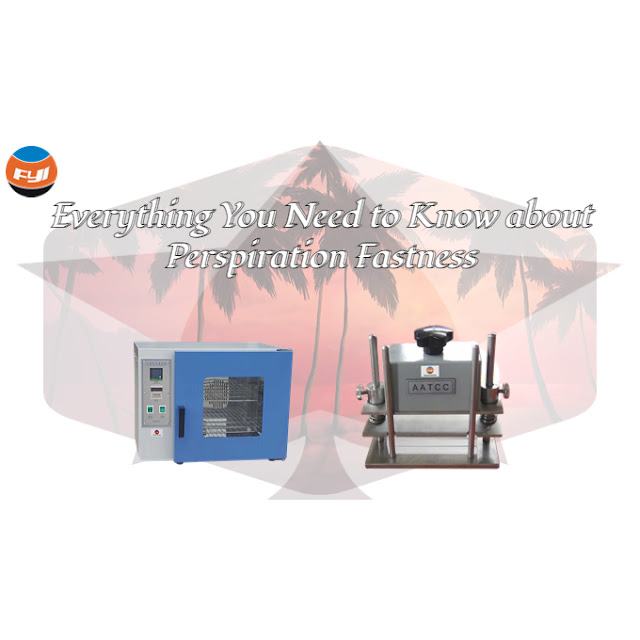Everything You Need to Know about Perspiration Fastness
What is perspiration fastness?
Perspiration fastness is the degree of color retention of textiles in sweat, which is especially important for clothing products.
During daily use, the textile stays in close contact with the skin for a long time. At the same time, contact with the sweat secreted by the skin will have a great impact on some dyes, causing them to transfer from the textile to the skin. Some of the dyes on textiles are not resistant to acid and some are not resistant to alkali. Therefore, during the test process, it is necessary to prepare acid and alkali artificial sweat to simulate the acid-base sweat of the human body. And test the textiles at 37°C to simulate human body temperature, mainly for textiles that are in contact with the skin.
During daily use, the textile stays in close contact with the skin for a long time. At the same time, contact with the sweat secreted by the skin will have a great impact on some dyes, causing them to transfer from the textile to the skin. Some of the dyes on textiles are not resistant to acid and some are not resistant to alkali. Therefore, during the test process, it is necessary to prepare acid and alkali artificial sweat to simulate the acid-base sweat of the human body. And test the textiles at 37°C to simulate human body temperature, mainly for textiles that are in contact with the skin.
The standard of perspiration fastness
At present, the common test standards for perspiration fastness mainly include: “Tests for Color Fastness of Textiles Part E04: Color Fastness to Perspiration” (ISO 105-E04: 2008); “Color Fastness to Perspiration” (AATCC 15: 2009).
AATCC 15 Tests for color fastness to acid perspiration. ISO 105 E04 goes a step further and tests color fastness to acidic and alkaline perspiration.
Human sweat is usually acidic. But it becomes alkaline at higher temperatures or in the presence of bacteria. So the ISO standard is more thorough in this case.
AATCC 15 Tests for color fastness to acid perspiration. ISO 105 E04 goes a step further and tests color fastness to acidic and alkaline perspiration.
Human sweat is usually acidic. But it becomes alkaline at higher temperatures or in the presence of bacteria. So the ISO standard is more thorough in this case.
Determination of color fastness to perspiration(BS EN ISO 105-E04)
Overview
Scope of application: Applicable to the color fastness test of various textiles to perspiration.
Principle: The textile sample is combined with the specified adjacent fabric and placed in two different test solutions containing histidine. After being treated separately, remove the test solution and place it between two flat plates with specified pressure in the test device. Under the specified temperature conditions, place the specified time, and then dry the sample and the adjacent fabric separately. Use the gray scale or instrument to evaluate the discoloration of the sample and the staining of the adjacent fabric.
Equipment and materials
Test equipment: including a stainless steel frame; a weight weighing 5kg and a bottom area of 11.5cm×6cm, attached with a glass plate or acrylic resin plate of the same size and a thickness of 0.15cm. The combined sample must be 10cm×4cm to ensure that the sample is under pressure of 12.5kPa.
Thermostat: Keep warm at 37±2°C.
Reagent:1) . L-histidine hydrochloride monohydrate2) . Sodium chloride3) . Disodium hydrogen phosphate dodecahydrate or disodium hydrogen phosphate dihydrate4) . Sodium hydrogen phosphate dihydrate5) ) . Sodium hydroxide
Backing Fabric: Use one piece of multifiber backing or two pieces of monofilament backing.
Gray scale for assessing discoloration and staining.
Scope of application: Applicable to the color fastness test of various textiles to perspiration.
Principle: The textile sample is combined with the specified adjacent fabric and placed in two different test solutions containing histidine. After being treated separately, remove the test solution and place it between two flat plates with specified pressure in the test device. Under the specified temperature conditions, place the specified time, and then dry the sample and the adjacent fabric separately. Use the gray scale or instrument to evaluate the discoloration of the sample and the staining of the adjacent fabric.
Equipment and materials
Test equipment: including a stainless steel frame; a weight weighing 5kg and a bottom area of 11.5cm×6cm, attached with a glass plate or acrylic resin plate of the same size and a thickness of 0.15cm. The combined sample must be 10cm×4cm to ensure that the sample is under pressure of 12.5kPa.
Thermostat: Keep warm at 37±2°C.
Reagent:1) . L-histidine hydrochloride monohydrate2) . Sodium chloride3) . Disodium hydrogen phosphate dodecahydrate or disodium hydrogen phosphate dihydrate4) . Sodium hydrogen phosphate dihydrate5) ) . Sodium hydroxide
Backing Fabric: Use one piece of multifiber backing or two pieces of monofilament backing.
Gray scale for assessing discoloration and staining.
More information can be found here.




Comments
Post a Comment